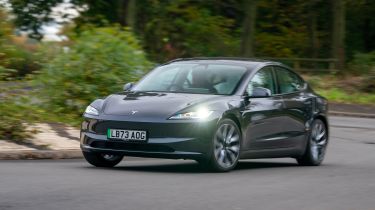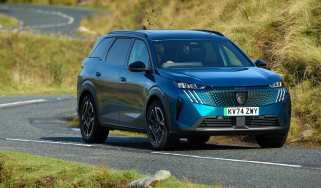Tesla Model 3: performance, motor & drive
Aside from point and squirt performance, the Model 3 offers little in the way of driver engagement
| Model | 0-60mph | Top speed | Driven wheels | Power |
| Standard Range | 5.8s | 125mph | Rear | 242bhp |
| Long Range | 4.2s | 125mph | Four | 346bhp |
| Performance | 2.9s | 163mph | Four | 453bhp |
Even if you don’t know much about Teslas, you’ve probably seen videos of them embarrassing supercars with their frankly bonkers acceleration. This is also the case for the Model 3, with even the base version giving some hot hatches a reason to sweat.
Unfortunately, while the initial burst of acceleration is savage, things tend to tail off once you surpass 60mph. The Model 3 isn’t exactly much fun to drive other than in a straight line, either — those looking for an engaging electric family car should check out the Cupra Born or BMW i4.
Tesla Model 3 0-60mph, top speed and acceleration
Tesla Model 3 buyers are faced with a simple choice: do they want something fast, or something even faster? Even the entry-level version is quick off the line, and is capable of 0-60mph in under six seconds. Upgrade to the Long Range model and you benefit from an extra electric motor on the front axle. This brings four-wheel-drive traction and a pretty thrilling 4.2-second 0-62mph time. Acceleration is as instant as you’d expect, nevertheless it’s easy to judge the throttle response and drive smoothly.
Naturally, it’s the Tesla Model 3 Performance which is by far the maddest of the bunch. The quoted 2.9-second 0-60mph time and 163mph top speed speak for themselves, and a £60,000 starting price means the Performance offers pretty solid value for money, too.
Buried deep in the infotainment system are two drive modes: Chill and Normal. While the latter offers the instant ‘kick-in-the-back’ you expect from an EV, Chill is designed to offer more gradual acceleration, much like a petrol or diesel car. Of course, while you aren’t quite catapulted up the road as violently as before, it’s not really much slower.
Handling
While much of the same vocabulary can be used to describe a supercar and the Model 3 in terms of acceleration, the best word to outline the Tesla’s driving experience is ‘adequate’. Sure, there’s very little body roll thanks to the car’s low centre of gravity, and there’s plenty of grip on dual-motor models, but the steering can feel a little disconnected from the road. Delve once again into the infotainment system and ‘Sport’ steering mode can weight things up a bit, but a BMW i4 still offers more feedback.
What we will say, however, is that Tesla certainly delivered on its promise of extra sophistication with the facelifted Model 3; the updated car soaks up bumps much better than the old car thanks to a recalibrated suspension setup. All-round acoustic glass also means the cabin is quieter than before when on the move; a BMW i4 is, once again, the king in this regard, but we’d rather travel long distances in the Tesla than a Polestar 2.




